National Oceanography Center
-
- Voices: NOC Executive Director Ed Hill Marine Technology, Jun 2017 #20
At the National Oceanography Center (NOC) in Southampton, U.K. for Ocean Business 2017, Marine Technology Reporter was able to sit down with Professor Ed Hill, NOC Executive Director, to discuss the science and technologies moving ocean studies forward.
Please give an overview of your activities here at the National Oceanography Center.The National Oceanography Center is part of the Natural Environment Research Council which is the main body that funds environmental science, including oceanography, in the U.K. We are a national facility. We undertake research in large-scale oceanography, everything from physics and climate through to ocean biology through to sea floor processes, with a big program in marine technology development and innovation. We also run major national infrastructure like our global class research ships, the Discovery and James Cook, as well as the National Oceanographic Data Center. So we’re an asset here to do great science but also to enable the whole of the U.K science community based in universities to be able to do big ocean science, as well.Obviously, the ocean is very near and dear to your heart. But from your point of view, why study the oceans?There are really three big challenges facing society. By 2050 there are going to be 9 billion people living on earth, and 70 percent of them will be living within 70 km of the coast in low-lying coastal regions and megacities around the world. And so that sparks three big issues: first, how are we going to feed 9 billion people, where are we going to get clean supplies of energy to power our economies, where are we going to get the strategic minerals that we need in the future, and the new medicines that we’re going to need to combat disease? We are looking to the ocean for the solution to many of those questions, and we need to be able to exploit those resources in a sustainable way such that the oceans’ future productive capacity and the ability to continue to supply resources is as good tomorrow as it is today. So that’s the first big challenge.The second one is most of those 9 billion people are going to be living in low-lying coastal regions and vulnerable to coastal flooding, which is the biggest natural disaster risk that faces most people across the world. Here in Britain, our biggest natural disaster risk is storm surge flooding and our capital city, which is very low-lying and very vulnerable to coastal flooding.And then the final challenge is how do we make sense of a lot of really big changes that are happening across the globe, whether that be the change in variability in our weather and climate, right through to there is a major loss of biodiversity happening across the planet, both on land and in the ocean. If we want to make sense of any of this global change, we’ve got to make sense of the ocean. And despite all of this and its importance, we know more about the surface of the moon and Mars and even the planet Pluto, it has to be said, than we do about our own ocean. So there’s a lot to find out.How long have you been involved in this industry, and what got you interested in the oceans to begin with?I started off like many oceanographers: in a completely different discipline. I’m an applied mathematician and that’s how I started. I was always interested in the sea since I was brought up by the sea when I was a kid. I became interested in fluid dynamics and then realized the ocean was a great place for that. I’ve been running research institutes for nearly 20 years, first a small institution, and then I had the privilege to be in charge of the U.K.’s National Oceanography Center.What do you consider to be your greatest challenge in keeping the activities of the NOC moving forward?Well, like every oceanographic institution in the world, everyone will tell you they don’t have enough money or resources. The challenges in front of us are enormous, and that means we are continually looking for resources. Here in the National Oceanography Center we’re certainly looking to diversify the opportunities to maintain the capability that you need to do really big science. And there are half a dozen institutes around the world with this scale and capable of doing it. So that’s a big issue.The ways of going about that, though, are common because we have huge opportunities. For example, the OECD produced a report in 2016 that forecast the ocean economy would grow from $1.5 trillion a year to $3 trillion a year by 2030. That’s a doubling and it’s certainly a much higher growth rate than the average growth rate of the global economy. There are huge opportunities in the ocean, an we are moving ever deeper into the ocean to meet these challenges. So, actually, there is a much wider range of customers and users interested in the science that we are doing and the technologies that we are generating. So I think that’s the first challenge, is to engage in the right way with those people.The other big challenge that we have is that no one institute, no one country can do this science on their own. International cooperation is the name of the game. We are working with big institutes across the world to try to understand how we can share out the load of measuring the ocean to understand its processes and change.We talk regularly about big data – the amount of data that is being collected, and turning that data into useable information. Can you put in perspective the challenge that you see surrounding big data?Historically oceanography’s problem is that it didn’t have enough data. Since 2000, with the advent of the Argo Float Program, we’ve been on the journey of being able to make more measurements in the ocean. Last year, I think we completed the millionth Argo Float profile. More data has been collected in the last 10 years than in the whole history of oceanography beforehand. So that presents new challenges and new opportunities.Such as?The first thing I think that is really important is to recognize that we actually are on the cusp of a technological revolution in being able to measure the ocean: a continuous presence and a much more diverse range of parameters that we’re measuring. We’re on the journey, and transformative technologies are making that happen. I am convinced that in 10 and certainly 20 years’ time the way in which we are collecting data from the ocean will be very different from today and we will have a vast volume of data. Which then brings me to the challenge that you’ve identified is how to manage that data and to turn it into actionable products. We are going to have to be much more adept at handling real-time data. And the sensors that we develop need to have the data management problem recognized at the outset so that they’re actually collecting the metadata that goes with it and stamping it and so that the whole data management problem is starting with the design of the sensor. Then the issue is about making sure that we can put this data together from across the world’s ocean. Increasingly the problems that we’re dealing with are not just about the ocean itself – it’s the way it couples with the atmosphere, with water coming off from the land. So we need to make data much more interoperable across the whole of the earth system.How do you see this data structured for maximum impact?This is not about taking all this data and putting it in one massive data center where we could pick it out. It’s about being able to access, and discover, and search this data using Semantic Web type technologies such that we can suck out these data from the disparate places where it’s held and then fuse them together. And then there’s the issue of how is that data actually turned into the things that people want to use, which is about engaging and finding common languages with the users – whether they be in the business sector or in government – as to what is really needed so that we can turn those raw data into really usable products. The real secret of this is actually not about pushing data out. It’s about enabling the relevant users to access, to be able to discover and pull out the data they want, and that’s a different kind of growth because many of the products that are needed will come from the users themselves, provided that they can have access to the data in ways that are searchable, which they are not at the moment in ways that they need to be. So it’s turning this whole data challenge on its head in many ways.
From the standpoint of the NOC, what are you doing to help scientists and technologists take their ideas so that they can be out in the world to “make a difference?”Absolutely right, Greg, this is really important, to turn great science into great business innovation, to create jobs and create great businesses that can work effectively in the ocean. We have been working very hard at this in the National Oceanography Center.The area of technology that we’re particularly interested in and have great capability in is autonomous and robotic systems, both in terms of their vehicles. We started in this game about 25 years ago making deep-sea submersibles that were all autonomous, and we’ve done some great science with it. Many of those science and advances now have practical applications in much more mundane but very useful applications.For example, we discovered the world’s deepest, hottest, hydrothermal vents by sniffing out their plumes with chemical sensors on an autonomous vehicle. The same technology has got applications for sniffing out precursor chemicals from carbon-capturing storage sites subsea. Some of the technologies that we used for exploring underneath Antarctic ice shelves – where you are completely remote from the ship and you need a truly autonomous capability – are now being used in things like pipeline survey. So what we’ve been doing here is trying to bring small technology companies to work alongside us, companies that are interested in developing these systems and the micro sensors that you put aboard them, as well as bring in companies who are not so interested in developing the technology but want to shape the way that it evolves and are interested in using it; primarily oil and gas majors and defense companies at the moment.Are there any tangible manifestations of this effort at the National Oceanography Center?Eighteen months ago we opened here in Southampton a Marine Robotics Innovation Center, and we are working now with about 20 companies – large ones who are users and small companies who are working alongside us in a number of projects to develop innovative autonomous systems. It has been successful and growing, and we have many projects underway; it is a real hub for bringing all of us together: academics, the users, technology companies, as well as engaging with some of the public regulators of how this technology will be used in the ocean. We are trying to play the role of a hub to be a bridge in this innovation landscape, and we’ve certainly grown our engagement with small companies, actually taking some of those products to global markets right now. It’s a success story, but we believe there’s a lot more to be done in this space and we are very excited about it.I can only imagine that a center of this magnitude requires continuous investment. Looking at the NOC and at investments going forward, what are your priorities? Where are you investing today for tomorrow?The areas that we’re investing in is in the technology space for two reasons. One is that will enable us to work with businesses. It’s a way of diversifying our income and it’s a way of demonstrating to government, who is the primary funder of oceanographic sciences, that it’s worth putting public money into oceanographic sciences because we do make a real difference to businesses. Also we are investigating technologies because this is going to transform the science – the things that we need to be doing scientifically are going to be transformed by new technologies. And all the greatest discoveries in oceanography have been enabled by new technologies, so we’re putting a huge emphasis on this. But our big challenge is to try to understand the way in which the earth system functions, the way in which the ocean is changing, and its variability which is causing enormous challenges and opportunities to human society – the carbon cycle, the way ecosystems are changing and the way in which the ocean processes are affecting sea level and weather. That’s the science that’s motivating us, but it’s the technology that’s enabling it, and that’s where we’re putting our big focus right now.Marine Technology TVThe previous is excerpted from a video interview recorded with Professor Hill at the National Oceanography Center in Southampton. See the full video here.(As published in the June 2017 edition of Marine Technology Reporter) -
- MTR100: National Oceanography Centre (UK) Marine Technology, Jun 2019 #64
National Oceanography Centre (UK)Southampton, UKPresident/CEO: Ed Hill OBENo. of Employees: 620www.noc.ac.ukThe National Oceanography Center (NOC) is the UK’s leading institution for integrated coastal and deep ocean research. NOC undertakes and facilitates world-class, agenda-setting scientific research to
-
- Study: Rising Sea Level Puts 150 Million at Risk Marine Technology, Jun 2014 #22
to rise. Ocean warming and glaciers/ice sheets melting are the causes of the sea level rise, said Dr. Svetlana Jevrejeva from the U.K.’s National Oceanography Center (NOC), who coauthored the scientific research paper “Trends and acceleration in global and regional sea levels since 1807,” which examines
-
- Ocean Business Sold Marine Technology, May 2013 #36
another successful run, three days packed with conferences, exhibition and on-water demonstrations. Held every two years since 2007 at the National Oceanography Center, Southampton, Ocean Business has quickly emerged as one of the leading subsea events, drawing an estimated 300 exhibitors and 4,000 attendees
-
- OSIL Giant Snow Catchers Used for NERC Research Marine Technology, Nov 2013 #59
The National Oceanography Center (Southampton) has recently purchased two Giant Snow Catchers from Havant-based oceanographic systems company OSIL (Ocean Scientific International Ltd.), for use in the NERC funded Shelf Sea Biogeochemistry research program next year. Marine Snow Catchers are crucial to
-
- Sonardyne Aids NOC Marine Technology, May 2013 #38
2 USBL acoustic positioning system played a role in the recent discovery of the world’s deepest known undersea volcanic vents by a team from the National Oceanography Center (NOC) in Southampton. The expedition used Ranger 2 to track the Remotely Operated Vehicle (ROV) Isis from the RRS James Cook, 5,000 meters
-
- Blue Tech Economy and the 'View from the Top' Marine Technology, Dec 2014 #10
Brand Architecture Environmental Leadership: Pacific Tugboats International Maritime Partner: Southampton University and the National Oceanography Center (UK) Marine Science Teaching: Rosie Beck, St. Martin of Tours Academy Maritime Technology Lifetime Achievement: Nancy
-
- Halls of Higher Learning Marine Technology, Aug 2016 #46
, UK Tel: +44 (0)23 8059 6666 www.noc.ac.uk A merger in April 2010 between Liverpool’s Proudman Oceanographic Laboratory and Southampton’s National Oceanography Center, gave rise to the UK’s leading institution for ocean research and technology development. From the coast to the deep ocean, the National
-
- Preview: Ocean Business 2017 Marine Technology, Feb 2017 #16
combining an exhibition and program of hands-on training and demonstration sessions. Ocean Business 2017 is scheduled to take place at the National Oceanography Center in Southampton, U.K. from April 4 to 6, 2017. Firmly established as one of the most important international events in the ocean technology
-
- Mapping the Abyss with AUV Photography Marine Technology, Mar 2015 #32
we understand the abundance, distribution and biodiversity of animals in the deep-sea,” said Dr. Kirsty Morris, Seabed Image Analyst at the UK’s National Oceanography Center (NOC) and the lead author of this research, published in ‘Limnology and Oceanography: Methods.’ “Only by knowing this, will we be able to
-
- A chat with John Murray, Chief Executive, Society of Maritime Industries Maritime Reporter, Jun 2015 #56
Technology and Innovation Group. He also serves on the Board of SEA Europe, based in Brussels; a member of the Advisory Council of the National Oceanography Center; a member of the UK Government’s Marine Industry Liaison Group of the Marine Science Coordination Committee; and a member of the Transport
-
- Marine Autonomy: The Future is Being Revealed Marine News, Jul 2021 #20
, the human elements continue to be addressed. In early June, the U.K.’s Royal Navy, training specialist SeaBot XR and the U.K.’s National Oceanography Center signed a memorandum of understanding (MOU) to create the National Center for Operational Excellence in Marine Robotics, a training center
-
 )
March 2024 - Marine Technology Reporter page: 45
)
March 2024 - Marine Technology Reporter page: 45and scienti? c research sectors. • Greensea IQ Signs Contract with BUVI Greensea IQ, announced the signing of BUVI Scandinavia (BUVI) to join its international sales team, which follows another recent signing of the Spanish sales representative Uniformidad Y Suminstros De Proteccion (USP). Cumu- latively
-
 )
March 2024 - Marine Technology Reporter page: 37
)
March 2024 - Marine Technology Reporter page: 37miscible barrier ? uid heavier than seawater (sg=1.026) and lighter than the battery electrolyte (sg=1.265). The original cell vent cap was screwed into the top of the riser pipe to vent the gases associated with charging. Wires were soldered to the lead (Pb) posts. The lead-acid battery was additionall
-
 )
March 2024 - Marine Technology Reporter page: 36
)
March 2024 - Marine Technology Reporter page: 36LANDER LAB #10 Of special interest for marine applications, LiPo batteries are Shipping any kind of lithium battery can be a challenge, and offered in a “pouch” design, with a soft, ? at body. The pouch IATA regs vary with the batteries inside or outside an instru- is vacuum-sealed, with all voids ?
-
 )
March 2024 - Marine Technology Reporter page: 26
)
March 2024 - Marine Technology Reporter page: 26the Hunga Tonga-Hunga Ha’apai volcano 3D map completed with data from the TESMaP voyage on Tongaroa and later ? lled in by Maxlimer from SEA-KIT International. Jasmin McInerney, Ocean Instrument Engineer, Employment of technology during talking to crew in the workboat deploying the glider. Phase One of
-
 )
March 2024 - Marine Technology Reporter page: 25
)
March 2024 - Marine Technology Reporter page: 25shore Wind Turbine Phase two, mapping inside the caldera, • Geotechnical InvesO gaO on • Sand Resource InvesO gaO on featured SEA-KIT International’s USV Maxlimer and marked the ? rst time an uncrewed surface vessel had been used to survey the aftermath of subsea volca- nic activity. Controlled
-
 )
March 2024 - Marine Technology Reporter page: 23
)
March 2024 - Marine Technology Reporter page: 23. Submarine volcanoes are largely unknown, in contrast with their sub-aerial (above-ground) counterparts. Kevin Mackay, marine ge- ologist at the National Institute of Water and Atmosphere Research (NIWA), New Zealand, said, “There are over one million underwater volcanoes, although only about 120
-
 )
March 2024 - Marine Technology Reporter page: 13
)
March 2024 - Marine Technology Reporter page: 13nyone familiar with glider hardware options integrated for a broad Glider answers that need,” said Shea autonomous underwater ve- range of missions. Quinn, Slocum Glider Product Line hicles (AUVs) is certainly “As the use of Slocum Gliders grew, Manager at TWR. A familiar with the popular- so did
-
 )
March 2024 - Marine Technology Reporter page: 8
)
March 2024 - Marine Technology Reporter page: 8in the northwestern Black They now pose a hazard to all maritime traf? c, regardless of Sea, which would not only have ceded control of Odessa, but national origin, prompting Turkey, Bulgaria, and Romania to enabled Russia to open up a second front. By all indications form a joint mine countermeasures
-
 )
March 2024 - Marine Technology Reporter page: 6
)
March 2024 - Marine Technology Reporter page: 6received Undersecretary and Assistant an honorary Doctor of Sci- Secretary of Commerce, acting and Deputy Administrator of the ence degree from Shang- National Oceanic and Atmospheric Administration (NOAA), and hai Ocean University in 2018. He proposed making thick wall Oceanographer of the Navy. He has
-
 )
April 2024 - Maritime Reporter and Engineering News page: 38
)
April 2024 - Maritime Reporter and Engineering News page: 38, Guatemala and El Salvador. Each ship will feature 300 Image courtesy HRDD refrigerated unit plugs. The four Avance-class ships are named after national birds, archaeological sites and lakes in Central lassNK granted its “SCCS-Full” class notation to America, Crowley said on social media. The newbuilds
-
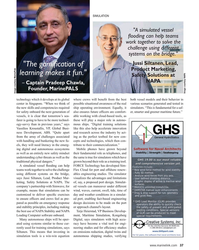 )
April 2024 - Maritime Reporter and Engineering News page: 37
)
April 2024 - Maritime Reporter and Engineering News page: 37SIMULATION "A simulated vessel ? ooding can help teams work together to solve the challenge using different systems on the bridge." – Jussi Siltanen, Lead, "The gami? cation of Product Marketing, learning makes it fun." Safety Solutions at NAPA – Captain Pradeep Chawla, Founder, MarinePALS Image
-
 )
April 2024 - Maritime Reporter and Engineering News page: 35
)
April 2024 - Maritime Reporter and Engineering News page: 35SIMULATION e have a close relationship with tech- Realism is prized beyond immersive, photo-realistic visu- nology, evidenced by, for example, als, and providers are introducing increasingly accurate func- the phones we are estimated to un- tionality. FORCE Technology’s upcoming DEN-Mark2 math- lock around
-
 )
April 2024 - Maritime Reporter and Engineering News page: 27
)
April 2024 - Maritime Reporter and Engineering News page: 27worked We are in that tough period with both recruiting and reten- their way up the “hawsepipe” from able bodied seaman to tion at the same time. It’s a national problem. master on our ships. We really want to grow our mariners We need to ensure our pay and bene? ts; the predictability from within. There’s
-
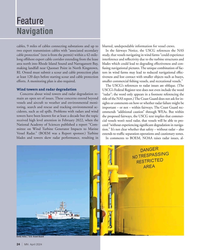 )
April 2024 - Marine News page: 24
)
April 2024 - Marine News page: 24USCG text implies that commer- received high level attention in February 2022, when the cial vessels won’t need radar, that vessels will be able to pro- National Academy of Sciences published a report “Com- ceed “without experiencing signi? cant degradation in naviga- mittee on Wind Turbine Generator Impacts
-
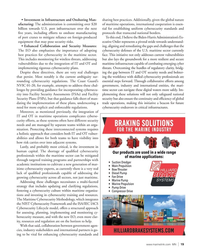 )
April 2024 - Marine News page: 19
)
April 2024 - Marine News page: 19Man- sharing best practices. Additionally, given the global nature ufacturing: The administration is committing over $20 of maritime operations, international cooperation is essen- billion towards U.S. port infrastructure over the next tial for establishing uniform cybersecurity standards and ? ve years
-
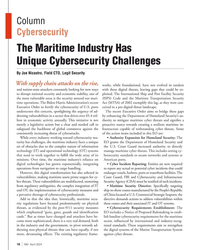 )
April 2024 - Marine News page: 18
)
April 2024 - Marine News page: 18not evolved in tandem and nation-state attackers constantly looking for new ways with these digital threats, leaving gaps that could be ex- to disrupt national security and economic stability, one of ploited. The International Ship and Port Facility Security the most vulnerable areas is the security around
-
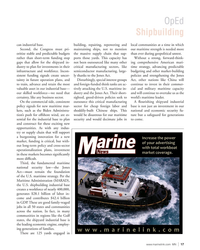 )
April 2024 - Marine News page: 17
)
April 2024 - Marine News page: 17mar- sector for cheap foreign labor and base is not just an investment in our kets, such as the Biden Administra- shoddily-built Chinese ships. This national and economic security fu- tion’s push for offshore wind, are es- would be disastrous for our maritime ture but a safeguard for generations sential
-
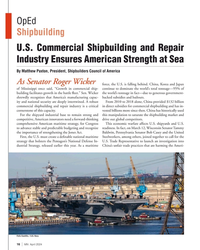 )
April 2024 - Marine News page: 16
)
April 2024 - Marine News page: 16the world’s tonnage in fact—due to generous government- shrewdly recognizes that America’s manufacturing capac- backed subsidies and bailouts. ity and national security are deeply intertwined. A robust From 2010 to 2018 alone, China provided $132 billion commercial shipbuilding and repair industry is a
-
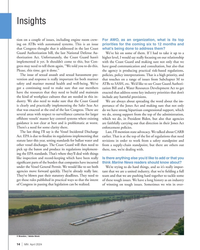 )
April 2024 - Marine News page: 14
)
April 2024 - Marine News page: 14six to 12 months and that Congress thought that it addressed in the last Coast what’s being done to address them? Guard Authorization bill, the last National Defense Au- We’ve hit on some of them. If I had to take it up to a thorization Act. Unfortunately, the Coast Guard hasn’t higher level, I would
-
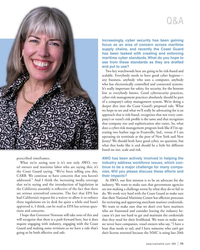 )
April 2024 - Marine News page: 11
)
April 2024 - Marine News page: 11. The fact that EPA has do. We work very hard with the Coast Guard to make sure had California’s request for a waiver to allow it to enforce that their National Maritime Center has ef? cient processes these regulations on its desk for quite a while and hasn’t for reviewing and approving merchant mariner
-
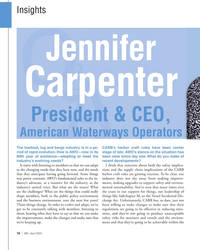 )
April 2024 - Marine News page: 10
)
April 2024 - Marine News page: 10Insights Jennifer QQQQQQQQQAAA & Carpenter President & CEO, American Waterways Operators The towboat, tug and barge industry is in a pe- CARB’s harbor craft rules have been center riod of rapid evolution. How is AWO—now in its stage of late. AWO’s stance on the situation has 80th year of existence—adapt
-
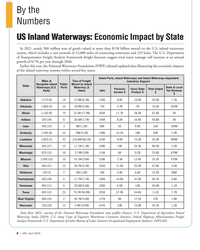 )
April 2024 - Marine News page: 8
)
April 2024 - Marine News page: 8Analysis Framework freight forecasts suggest total water tonnage will increase at an annual growth of 0.7% per year through 2040. Earlier this year, the National Waterways Foundation (NWF) released updated data illustrating the economic impacts of the inland waterway systems within several key states. Inland
-
 )
February 2024 - Maritime Reporter and Engineering News page: 44
)
February 2024 - Maritime Reporter and Engineering News page: 44Tech Files Latest Products & Technologies MarineShaft Yanmar Hydrogen MarineShaft specializes in urgent re- Fuel Cell AIP pair/replacement of damaged rudder and Yanmar Power Technology Co., Ltd. propeller equipment along with many (Yanmar PT), a subsidiary of Yanmar on-site repair services. MarineShaft
-
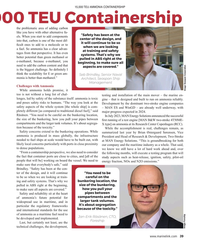 )
February 2024 - Maritime Reporter and Engineering News page: 39
)
February 2024 - Maritime Reporter and Engineering News page: 39tank volumes. widespread use in maritime, and in It’s about segregation particular the regulatory frameworks because of the toxicity.” and international standards for the use of ammonia as a maritime fuel need to Jan-Erik Räsänen, CTO, be developed and implemented. Foreship Last, but certainly
